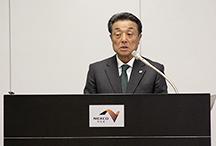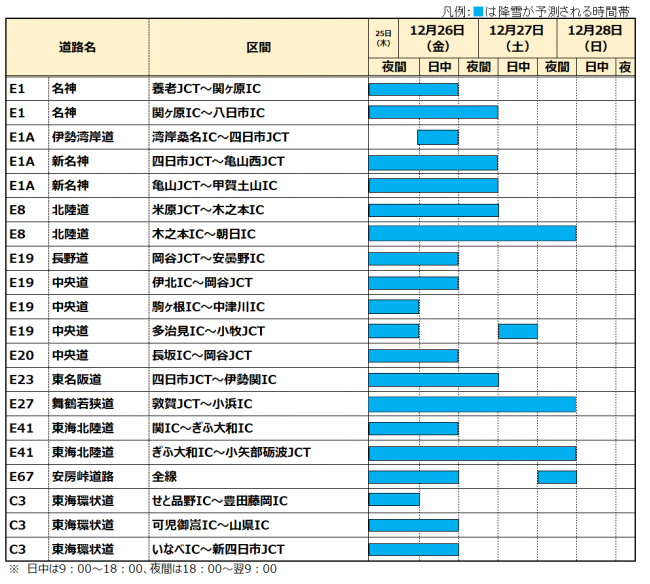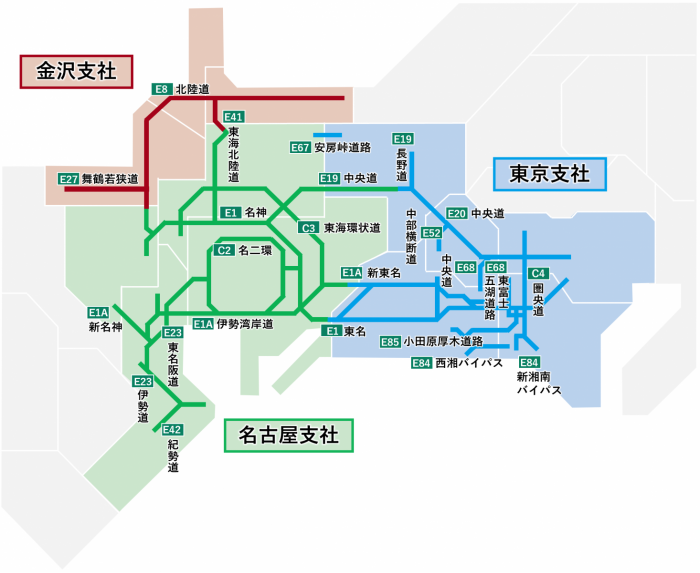会見要旨
【司会】
皆さまお待たせいたしました。ただいまから第120回の定例会見をはじめさせていただきます。

【はじめに】
【宮池社長】
会見を始める前に、一言申し上げます。
笹子トンネル天井板落下事故が起きてから、今月2日で4年がたち、同日、山梨県内で追悼慰霊式を執りおこないました。
追悼慰霊式では、お亡くなりになられた皆さまに心よりご冥福をお祈り申し上げるとともに、ご遺族の皆さまに対して深くお詫びを申し上げ、
私たちは、あらためてこの事故をしっかりと胸に刻み込み、決して事故を風化させぬよう、グループ全体でこれからも更なる安全性向上と機能強化の取組みを推進しますことをお誓い申し上げました。
当日の取材に関しましては、皆さまにご協力をいただき、ありがとうございました。
【事業の現況(2016年11月)】
資料1をご覧ください。
営業の状況ですが、11月の料金収入は553億8800万円で対前年同月比2.3%の増加、また、通行台数は日平均200万4000台で対前年同月比3.1%の増加となりました。
11月は、新東名の開通効果や東名集中工事が昨年の11月から今年は9月~10月に変更となったことから、料金収入・通行台数ともに増加となりました。
続いて建設の状況ですが、新規区間につきましては、のちほどトピックでご説明します。
資料1の地図をご覧ください。
圏央道・八王子西インターチェンジ(IC)関越道方面出入口が、今週末の12月24日に、また、北陸道・小谷城スマートICが、2017年3月25日に開通しますのでお知らせします。
当社管内のスマートICは、営業中が22箇所、事業中が33箇所となっています。
次にサービスエリア(SA)の状況です。
11月のSA・パーキングエリア(PA)の売上高は156億1300万円で対前年同月比1.7%の増加、飲食・物販部門の売上高は、対前年同月比1.5%の減少となりました。
主な要因としましては、昨年は11月21日~23日が3連休でしたが、今年は飛び石連休となり日並びに恵まれなかったこと、また、昨年に比べて休日が1日少なかったこともあり、飲食・物販部門の売上高は対前年同月比98.5%となりました。
ガソリン部門の売上高は、昨年に対し販売価格差が縮まってきたことと、軽油の給油数量が昨年を上回ったことなどにより、対前年同月比9.6%の増加となりました。
【中部横断自動車道 六郷ICから増穂IC間が2017年3月に開通します】
資料2をご覧ください。
中部横断道の六郷ICから増穂ICまでの区間約9kmにつきまして、2017年3月に計画どおり開通できる見通しとなりました。
今回の開通により、清水港などへの所要時間短縮による生産性の向上、甲府市など周辺都市へのアクセス性の向上、救急医療活動の支援などが期待されます。
開通日時につきましては、今後の工事進捗などを踏まえ、あらためてお知らせします。
【中部横断自動車道 増穂ICから双葉JCT間で昼夜連続通行止めをおこないます】
資料3をご覧ください。
先ほどご説明しました中部横断道 六郷ICから増穂IC間の開通に先立ち、南アルプス本線料金所の移設工事が必要となります。また、移設工事に合わせて、損傷が著しい箇所の舗装の改良などリフレッシュ工事をおこないます。
このため、中部横断道の増穂ICから白根(しらね)IC間の上下線を、予備日4日間を含め、2017年2月20日(月)~3月10日(金)の19日間、白根ICから双葉ジャンクション(JCT)間の上下線を、予備日2日間を含め、2017年2月20日(月)~3月5日(日)の13日間、昼夜連続通行止めをおこないます。
お客さまには大変ご迷惑をおかけいたしますが、ご理解とご協力をお願いします。
【高速道路の安全性向上を目的とした「技術研修所」のご案内】
資料4をご覧ください。
当社の子会社である中日本ハイウェイ・エンジニアリング東京は、高速道路の安全性向上や点検に関する人材育成・技術力向上を目的とし、今年10月、神奈川県相模原市に「技術研修所」を開設しました。
当研修所には、より実践的で効果的な研修をおこなうため、実際の現場と同等の道路構造物や施設設備を設置しています。
例えば、半断面のトンネル設備では、覆工コンクリートの打音点検、水噴霧装置の流量測定訓練、消火栓・火災検知器などの防災連動訓練などをおこなうことができます。
また、実物大の橋梁サンプルやリニューアルプロジェクト(大規模更新・修繕事業)で発生した撤去部材を用いた橋梁点検訓練などをおこなうことができます。
現在、当社グループでは、名古屋大学構内にある橋梁保全技術の向上を目的とした「ニューブリッジ」や、岐阜県各務原市にある主に施設保全技術の向上を目的とした「E-MAC」といった研修施設を保有していますが、このたび、神奈川県相模原市に道路・設備保全技術全般の向上を目的とした研修施設が開設されたことにより、研修の充実と効率化が図られ、グループ全体の技術力が一層向上することを期待しています。
なお、当研修所では、今年10月の開設後もリニューアルプロジェクトで発生する撤去部材などを順次搬入しており、これらが一層充実する来年1月下旬頃、報道関係の皆さまをご案内したいと考えています。
詳細につきましては、後日あらためてお知らせします。
【高速画像処理を用いたトンネル内点検技術の開発】
資料5をご覧ください。
当社グループは、安全性向上に資する取組みの一環として、点検の高度化・効率化を目指した技術開発をおこなっています。
その中で、以前から開発をおこなってきました「高速画像処理を用いたトンネル内点検技術」につきまして、実用化に目途をつける研究成果が得られましたのでご報告します。
画像処理カメラを用いたトンネル内の点検技術開発は他でもおこなわれていますが、今回の特徴は、可搬式システムである点です。東京大学が開発した高速回転ミラーを使ったデジタル画像処理技術により、小型化が可能になりました。
写真にもあるように、車の上に乗せたカメラは容易に取り外しができるため、載せ替えが可能になっています。これにより専用車を必要とせず、コストを安く抑えています。
現在、トンネル構造物の点検は、5年に1度、交通規制をおこなった上で高所作業車を用いて近接目視や打音、触診により実施していますが、このシステムを使うことにより、日常の巡回時にもトンネルの状態を常にモニタリングすることができ、点検の信頼性をより向上させます。
現時点では点検作業の完全な代替えは難しいと考えていますが、今後、改良が進むことで、いずれ代わることが期待される技術です。
本研究では、別紙に記載しているように、時速100キロでもブレずにひび割れを検知することに成功しました。現在、カメラの精度を上げており、今年度末には0.2ミリまで検知できるようになります。
また撮影した画像は、自動でひび割れを検出できるため、作業が軽減すると考えています。
現在、カメラの最終調整をおこなっており、2018年の導入を目指しています。
今後、社会・経済環境の変化や、少子高齢化により労働人口が減少していく社会情勢などを見据え、ICT技術を活用したトンネルや橋梁点検の高度化、効率化技術の開発を引き続きおこなっていきます。
以上が本日ご用意したトピックです。
【司会】
それでは、これから皆さまからのご質問をお受けします。
【記者】
トンネル内点検技術の開発について、少し気の早い話ですが、2018年導入に向けて開発中とのことで、他の道路管理者も点検の高度化が課題になっている中、外部への技術提供などを展開していかれるのでしょうか。
【宮池社長】
完成した時点で、具体的に考えていきたいと思っています。
【記者】
技術研修所は10月に開設していますが、発表は今日ということでよろしいでしょうか。
【宮池社長】
すでに開設して運用していますが、先ほど申し上げましたように、資機材をまだ搬入しているところです。今日発表させていただき、来年1月に報道関係の皆さまをご案内するということです。
【記者】
トンネル内点検技術の開発について、今まではどのくらいの期間でやっていたことが、この技術を使うことで、どのくらい時間を短くできるのか教えてください。
【宮池社長】
トンネルの点検は、法令上は近接目視点検を5年に1回おこなうことになっており、高所作業車などを利用して人力でおこなうことが基本です。現在開発しているのは、常時巡回で走行している車両などにカメラを載せて撮影しながら、壁面の変状を継続して観察し、画像解析をおこなうことで5年に1回の近接目視点検の精度をさらに上げていこうというものです。常にデータを持って変化していくものをモニタリングしておけば、点検の精度もいっそう高まると思いますし、5年に1回の近接目視点検の時も、どこがポイントかということがはっきり分かるようになるので、非常に効果的であると思っています。
【記者】
トンネル内点検技術は2014年3月に一度、開発することを発表していたものが、本日、実現可能になったという、今の進捗状況を発表されたということですか。
【宮池社長】
現況報告ということです。
【記者】
実際に運用は2018年以降ということですか。
【宮池社長】
しばらくは実際のフィールドで精度を上げるべく試験をおこない、18年には実用化していきたいと思っています。
【記者】
NEXCO西日本も同じようなものを開発していると思うのですが、これはどういったもので、関係性などを教えてください。
【宮池社長】
西日本で開発しているのは、このようなミラー式のものではなくて、明るい光を当てながら写真を一気に撮影し、それを実際に絵にしていくという仕組みのものです。西日本の場合は、車も専用の車両ですが、当社のものは非常にコンパクトな可搬式システムなので、車への積み替えも可能で、常時走りながら点検できるという点で、性質が少し異なると思います。
【司会】
ご質問が途切れたようですので、これで定例会見を終了させていただきます。














 トンネル天井板の落下事故に関する調査・検討委員会
トンネル天井板の落下事故に関する調査・検討委員会
















 お問い合わせ
お問い合わせ


 イオンNEXCO中日本カード
イオンNEXCO中日本カード 重要なお知らせ
重要なお知らせ
 重要なお知らせ
重要なお知らせ

 閉じる
閉じる
